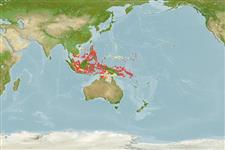>
Eupercaria/misc (Various families in series Eupercaria) >
Nemipteridae (Threadfin breams, Whiptail breams)
Etymology: Pentapodus: Greek, pente = five + Greek, pous = feet (Ref. 45335).
More on author: Bloch.
Environment: milieu / climate zone / depth range / distribution range
Ecología
marino asociado a arrecife; rango de profundidad 2 - 30 m (Ref. 9785). Tropical; 31°N - 16°S, 102°E - 166°E (Ref. 3810)
Western Pacific: Solomon Islands, New Guinea, western Caroline Islands (Palau, Yap), Philippines, East Malaysia, Indonesia and Singapore. This species has previously been misidentified as Pentapodus caninus by most authors.
Tamaño / Peso / Age
Maturity: Lm ? range ? - ? cm
Max length : 28.0 cm TL macho / no sexado; (Ref. 90102); common length : 15.0 cm SL macho / no sexado; (Ref. 3810)
Espinas dorsales (total): 10; Radios blandos dorsales (total): 9; Espinas anales 3; Radios blandos anales: 7. Some geographical variations. In Sulawesi shows yellow band intermittently because of other similar species in the same area (Ref. 48635). Head scales reaching forward to or just in front of level of anterior margin of eyes. Suborbital naked except for a small patch of scales beneath eyes. Lower limb of preopercle with 2 or 3 scale rows. Pelvic fins moderately long, reaching almost to level of anus. Axillary scale present. Color: Upper body dark grey or olive-brown, silvery white below. Presence of a narrow silvery white stripe joining eyes across snout just behind nostrils. Base of pectoral fin with a black bar.
Clear coastal to outer reef crests (Ref. 48635). Common in shallow sandy rubble and coral reef areas. Usually in aggregations. Feeds on small fishes, crustaceans and polychaetes during the day (Ref. 9710).
Life cycle and mating behavior
Madurez | Reproducción | Puesta | Huevos | Fecundidad | Larva
Russell, B.C., 1990. FAO Species Catalogue. Vol. 12. Nemipterid fishes of the world. (Threadfin breams, whiptail breams, monocle breams, dwarf monocle breams, and coral breams). Family Nemipteridae. An annotated and illustrated catalogue of nemipterid species known to date. FAO Fish. Synop. 125(12):149p. Rome: FAO. (Ref. 3810)
IUCN Red List Status (Ref. 130435)
Threat to humans
Harmless
Human uses
Pesquerías: pesquerías de subsistencia
Más información
Nombres comunesSinónimosMetabolismoDespredadoresEcotoxicologíaReproducciónMadurezPuestaAgregación para la puestaFecundidadHuevosEgg development
ReferenciasAcuiculturaPerfil de acuiculturaRazasGenéticaElectrophoresesheritabilidadEnfermedadesProcesamientoNutrientsMass conversion
ColaboradoresImágenesStamps, Coins Misc.SonidosCiguateraVelocidadTipo de nataciónSuperficie branquialOtolitosCerebrosVisión
Herramientas
Special reports
Download XML
Fuentes de Internet
Estimates based on models
Preferred temperature (Ref.
123201): 27.8 - 29.3, mean 28.8 °C (based on 1711 cells).
Phylogenetic diversity index (Ref.
82804): PD
50 = 0.5002 [Uniqueness, from 0.5 = low to 2.0 = high].
Bayesian length-weight: a=0.01950 (0.01104 - 0.03443), b=3.02 (2.87 - 3.17), in cm total length, based on LWR estimates for this species & (Sub)family-body (Ref.
93245).
Nivel trófico (Ref.
69278): 3.6 ±0.53 se; based on food items.
Resiliencia (Ref.
120179): Alto, población duplicada en un tiempo mínimo inferior a 15 meses (Preliminary K or Fecundity.).
Fishing Vulnerability (Ref.
59153): Low vulnerability (18 of 100).
Nutrients (Ref.
124155): Calcium = 58.1 [36.6, 118.6] mg/100g; Iron = 0.656 [0.323, 1.605] mg/100g; Protein = 19.1 [17.2, 20.8] %; Omega3 = 0.146 [0.089, 0.241] g/100g; Selenium = 27.2 [16.1, 48.9] μg/100g; VitaminA = 76.5 [21.9, 221.6] μg/100g; Zinc = 1.26 [0.88, 1.82] mg/100g (wet weight);
